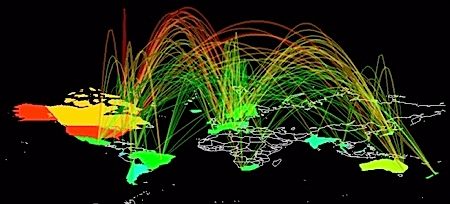The Internet is a world-wide network that has grown and evolved from an experimental network (ARPANet) created by the US military back in the 1960s. Over the years, as more and more computers and networks have connected to this network, it has grown into the Internet that we know today.

The Internet connects millions of people, and thousands of businesses, governments, schools, universities and other organisations.
What Can We Use the Internet For?
The Internet provides the network connections that links computers together. There are many ways that we can use these connections:
- View web pages on the WWW (World-Wide Web)
- Sending and receiving e-mail messages
- Sharing files
- Communicating using voice (VOIP) and video (video-conferencing)
- Playing multi-player games
- Listening to streamed music or watching streamed video

The small, hand-drawn map above show the plan for the first connections between four computers on the ARPANet. It was drawn by one of the engineers who created the network back in 1969.
From these tiny beginnings, the Internet has grown to a size that would be hard to believe forty years ago.
Statistics published at the start of 2008 show that 1.3 billion people now have access to the Internet (20% of world population).
From these tiny beginnings, the Internet has grown to a size that would be hard to believe forty years ago.
Statistics published at the start of 2008 show that 1.3 billion people now have access to the Internet (20% of world population).
